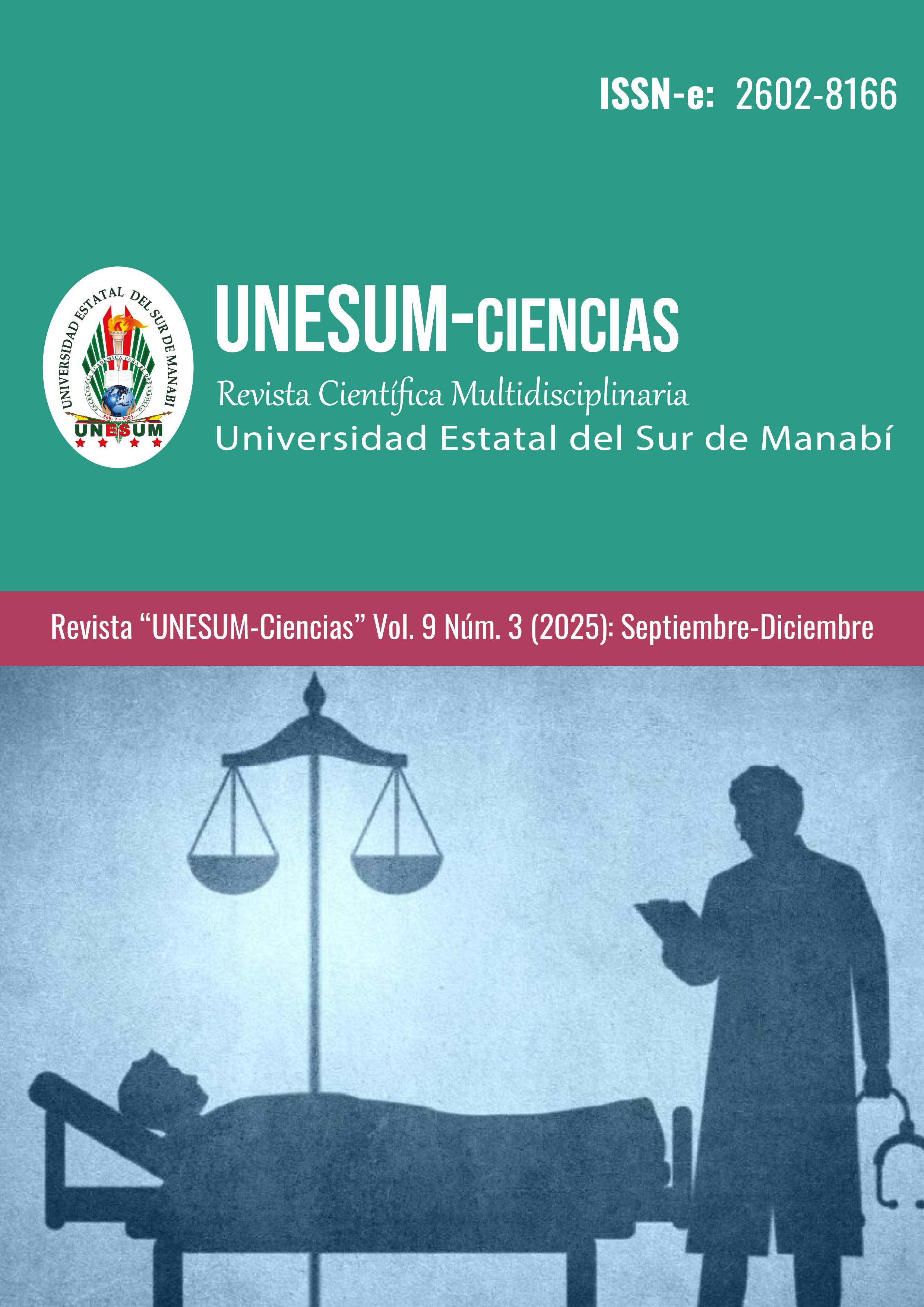Challenges of podiatric care for vulnerable groups
DOI:
https://doi.org/10.47230/unesum-ciencias.v9.n3.2025.220-227Keywords:
vulnerable groups; podiatric care; challenges.Abstract
Introduction: In Guayas, Ecuador, several vulnerable groups may face specific challenges regarding access to podiatric care and other health services. Objective: to establish the theoretical and methodological references that support the care process for vulnerable groups in the province of Guayas, Ecuador. Development: a descriptive study was conducted in the period from January 2019 to January 2024, the research is consolidated from the dialectical-materialist conception, for the collection of data and information processing were used as theoretical methods (systematization and systemic, structural and functional), to support the challenges faced by vulnerable groups in the province of Guayas, Ecuador. In addition, the empirical method of the interview was applied to 100 people selected intentionally. The results support the challenges faced by vulnerable groups as part of the systematization of the foundations of the theoretical and methodological references of the process of podiatric care. Conclusion: the systematization of the theoretical and methodological references that support the process of care for vulnerable groups, argues that proper podiatric care is that which allows preventing and treating a wide range of conditions that may affect the feet, ultimately, the health and general welfare of these people. Podiatric professionals are the only ones with the power and capacity to know all the issues that concern the proper functioning of the feet.
Downloads
References
Arzate, E. U., & Chávez, M. d. L. G. (2007). La protección jurídica de las personas vulnerables. Revista de derecho(27). https://rcientificas.uninorte.edu.co/index.php/derecho/article/download/2661/1773
Baños, R. V., Torrado-Fonseca, M., & Álvarez, M. R. (2019). Análisis de regresión lineal múltiple con SPSS: un ejemplo práctico. REIRE Revista d'Innovació i Recerca en Educació, 12(2), 1–10-11–10. https://revistes.ub.edu/index.php/REIRE/article/download/22704/28913
Borreiros, F. S., Cabanach, R. G., Romero-Soto, M., & Souto-Gestal, A. (2025). Calidad de la atención en podología universitaria. Análisis del cuestionario de satisfacción del paciente. Atención Primaria, 57(5), 103138. https://www.sciencedirect.com/science/article/pii/S0212656724002804
CEPAL, N. (2020). Agenda regional de desarrollo social inclusivo.
Fanego, C. A. (2022). Declaración de personas vulnerables y preconstitución de la prueba en el proceso penal. Revista Brasileira de Direito Processual Penal, 8(3), 1093-1126. https://www.scielo.br/j/rbdpp/a/jFY3P8GgsjDm9CbbVNqsPkB/?format=pdf&lang=es
Hernández, S. S. (2023). La importancia de la podología en la atención primaria. Atención Primaria, 56(2), 102811. https://pmc.ncbi.nlm.nih.gov/articles/PMC10873151/pdf/main.pdf
Levy, L. M. M. K., Niño, A. V. B., & Hooker, O. R. S. (2024). Empoderamiento y desarrollo social, claves para superar la pobreza. Ciencia Latina Revista Científica Multidisciplinar, 8(6), 201-219. https://ciencialatina.org/index.php/cienciala/article/download/14603/20812
Meneses Guevara, B. A. (2024). Límites de la Podología en México y su comparativo con el ejercicio en España y otros países. Revista CONAMED, 29(2). http://www.conamed.gob.mx/gobmx/revista/pdf/vol_29_2024/art_24.pdf
Montero, C. (2022). Vulnerabilidad humana y el uso del término adultos vulnerables ante los abusos eclesiales a mayores de edad. Teología y vida, 63(3), 345-366. https://www.scielo.cl/scielo.php?pid=S0049-34492022000300345&script=sci_arttext
Montoya Arce, B. J., & Martínez Espinosa, A. (2018). Perspectivas teórico-metodológicas para el estudio de la vulnerabilidad social en los adultos mayores. Papeles de población, 24(98), 219-244. https://www.scielo.org.mx/scielo.php?pid=S1405-74252018000400219&script=sci_arttext
Morelato, G. (2011). Maltrato infantil y desarrollo: hacia una revisión de los factores de resiliencia. Pensamiento psicológico, 9(17), 83-96.
Muñoz, M. d. l. P. C., Orduña, M. I. P., & Albert, D. P. (2024). Medidas de prevención del pie diabético realizadas por enfermería en atención primaria. Enfermería Dermatológica, 18(53), 15-19. https://dialnet.unirioja.es/descarga/articulo/9886899.pdf
Olmos, H. P., Sorensen, K. P., Mariño, A. C., Toro, H. J. D. A., Espinoza, J. X. M., & Narváez, E. Q. (2024). Calidad de la información en las historias clínicas de personas con diabetes mellitus tipo 2 sobre el cuidado de los pies en centros de atención primaria de salud de Ecuador. Atención Primaria Práctica, 6(4), 100213. https://www.sciencedirect.com/science/article/pii/S2605073024000233
Pons-Vigués, M., Casanovas-Guitart, C., Aventin, O. C., Negre, M. L., Valmaseda, A. B., Quirós, M. P., & Abat, C. C. (2025). Proceso de mejora de la prestación de atención podológica comunitaria en las personas con diabetes mellitus en Catalunya. Atención Primaria, 57(5), 103222. https://www.sciencedirect.com/science/article/pii/S0212656725000083
RAE. (2025). Diccionario de la lengua española. Edición tricentenario. https://dle.rae.es/vulnerable
Ramos Ojeda, D. (2019). Entendiendo la vulnerabilidad social: una mirada desde sus principales teóricos. Revista estudios del desarrollo social: Cuba y América Latina, 7(1), 139-154. http://scielo.sld.cu/pdf/reds/v7n1/2308-0132-reds-7-01-139.pdf
Villegas, M. Y. A. (2025). Calidad de la atención en podología universitaria. Análisis del cuestionario de satisfacción del paciente. Atención Primaria, 57(12), 103297. https://pmc.ncbi.nlm.nih.gov/articles/PMC12282157/
Downloads
Published
How to Cite
Issue
Section
License
Copyright (c) 2025 Damasa Irene López Santa Cruz

This work is licensed under a Creative Commons Attribution 4.0 International License.




